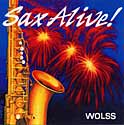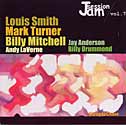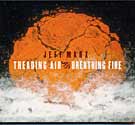| |
 
I N - T H I S - I S S U E :
 



Index of
SEMJA reviews
|
|
Recent Recordings by Area Musicians
BY PIOTR MICHALOWSKI
Christmas
is over and most of us have probably had more than our share of seasonal
music. In no way should this prevent you from getting a copy of the delicious
album, Christmas Songs for Jazz Lovers (PKO
23),
by the  Paul
Keller Ensemble. Paul Keller (bass), Ellen Roe (piano), Sean Dobbins
(drums), Paul Finkbeiner (trumpet), Chris Smith (trombone), and Keith
Kaminski (soprano, alto, and tenor saxes), share the bandstand every Wednesday
night at Ann Arbor's Firefly Club and the years of playing together on
a regular basis are evident on this recording, on which they are joined
by their old friend Cary Kocher on chimes, glockenspiel and sleigh bells.
The album mixes well-known Christmas songs such as "Silent Night"
with a few unusual numbers. The arrangements were all penned by the leader
and band members Roe, Finkbeiner and Smith. The settings vary in spirit
and feeling, but are all fine pretexts for some fine jazz blowing from
all the members of the band, providing all year round staying power for
the album. Certainly Finkbeiner's complex and soulful setting for "We
Three Kings" will compare well with other jazz renderings; he makes
the sextet sound almost like a big band and provides an inspiration for
some of the finest blowing on the date. Claude Thornhill's atmospheric
"Snowfall," and Chris Smith's ingenious arrangement of the "Dance
of the Sugar Plum Fairies" from The Nutcracker extend the range of
the offerings. It is interesting to compare the latter with the Ellington/Strayhorn
jazz version; the one recorded here is quite different, with a bluesy
feeling that infects the soloists very nicely. Paul
Keller Ensemble. Paul Keller (bass), Ellen Roe (piano), Sean Dobbins
(drums), Paul Finkbeiner (trumpet), Chris Smith (trombone), and Keith
Kaminski (soprano, alto, and tenor saxes), share the bandstand every Wednesday
night at Ann Arbor's Firefly Club and the years of playing together on
a regular basis are evident on this recording, on which they are joined
by their old friend Cary Kocher on chimes, glockenspiel and sleigh bells.
The album mixes well-known Christmas songs such as "Silent Night"
with a few unusual numbers. The arrangements were all penned by the leader
and band members Roe, Finkbeiner and Smith. The settings vary in spirit
and feeling, but are all fine pretexts for some fine jazz blowing from
all the members of the band, providing all year round staying power for
the album. Certainly Finkbeiner's complex and soulful setting for "We
Three Kings" will compare well with other jazz renderings; he makes
the sextet sound almost like a big band and provides an inspiration for
some of the finest blowing on the date. Claude Thornhill's atmospheric
"Snowfall," and Chris Smith's ingenious arrangement of the "Dance
of the Sugar Plum Fairies" from The Nutcracker extend the range of
the offerings. It is interesting to compare the latter with the Ellington/Strayhorn
jazz version; the one recorded here is quite different, with a bluesy
feeling that infects the soloists very nicely.
For
sheer beauty and musicality one should check out Sax Alive!
by WOLSS — that is, the World's Oldest Living Saxophone Section
(W102). The five saxophonists Larry
Teal Jr. (alto), Norm Gladstone (alto),  Fritz
Moore (tenor and clarinet), Nick Seiler (tenor), and Fred Boldt (baritone),
are accompanied by Tim Teal (guitar), Ernie Daunter (bass), and Chris
Teal (drums), who is replaced by Rich Michaels on four of the sixteen
numbers. This is ensemble music, with few solos, and it reminds one, as
the cover tells us, of "the big band sections of yore." The
compositions are familiar—"A Time for Love," "Over
the Rainbow," "Darn that Dream," etc.— and the arrangements
are idiomatic, from the pens of various writers, among which those of
Lennie Niehaus and especially those of Bob Florence stand out most prominently.
The lead alto player is the son of Larry Teal, the great saxophone master
teacher of the University of Michigan, and he would have been proud of
his family, including the grandchildren in the rhythm section. This is
lovely music, excellently played, full of lush sounds, good swing, and
a nice dab of shmaltz! Fritz
Moore (tenor and clarinet), Nick Seiler (tenor), and Fred Boldt (baritone),
are accompanied by Tim Teal (guitar), Ernie Daunter (bass), and Chris
Teal (drums), who is replaced by Rich Michaels on four of the sixteen
numbers. This is ensemble music, with few solos, and it reminds one, as
the cover tells us, of "the big band sections of yore." The
compositions are familiar—"A Time for Love," "Over
the Rainbow," "Darn that Dream," etc.— and the arrangements
are idiomatic, from the pens of various writers, among which those of
Lennie Niehaus and especially those of Bob Florence stand out most prominently.
The lead alto player is the son of Larry Teal, the great saxophone master
teacher of the University of Michigan, and he would have been proud of
his family, including the grandchildren in the rhythm section. This is
lovely music, excellently played, full of lush sounds, good swing, and
a nice dab of shmaltz!
From
trumpeter Louis Smith comes Jam Session, Vol. 7 (Steeplechase
SC
31546), with Mark Turner (tenor sax), Billy Mitchell (tenor sax),
Andy LaVerne (piano), Jay Anderson (bass), and Billy Drummond (drums).
 Smith
and Mitchell had played together at the Blue Bird in the fifties, but
had apparently never managed to do it again until this session, which
proved to be Mitchell's last (he died in 2001; see the SEMJA obituary).
Accompanied by a relaxed rhythm section, the three horns take a leisurely
stroll through some old jazz standards as well as originals by LaVerne
and Smith. The latter is in fine form throughout, and is especially effective
on an up tempo "Autumn Leaves" and on his ballad feature, "What's
New." The trumpet player was obviously inspired by the multi-generational
company and his enthusiasm shows in each solo. Billy Mitchell was one
of the great bop tenor players whose roots lay in an earlier style; he
combined modern harmonies with a big sound and sense of swing that remind
one of Don Byas and Lucky Thompson. By the time he made his last recording
his sound had become somewhat harder, but he could still play with elegance
and a joyous drive that only years of experience can give. The other tenor
sax player on the date, Mark Turner, a most talented young man, holds
his own next to the veteran of the Blue Bird, the Basie and Gillespie
bands, and his rendition of Gershwin's "I Loves You Porgy" is
one of the highlights of the album. Smith
and Mitchell had played together at the Blue Bird in the fifties, but
had apparently never managed to do it again until this session, which
proved to be Mitchell's last (he died in 2001; see the SEMJA obituary).
Accompanied by a relaxed rhythm section, the three horns take a leisurely
stroll through some old jazz standards as well as originals by LaVerne
and Smith. The latter is in fine form throughout, and is especially effective
on an up tempo "Autumn Leaves" and on his ballad feature, "What's
New." The trumpet player was obviously inspired by the multi-generational
company and his enthusiasm shows in each solo. Billy Mitchell was one
of the great bop tenor players whose roots lay in an earlier style; he
combined modern harmonies with a big sound and sense of swing that remind
one of Don Byas and Lucky Thompson. By the time he made his last recording
his sound had become somewhat harder, but he could still play with elegance
and a joyous drive that only years of experience can give. The other tenor
sax player on the date, Mark Turner, a most talented young man, holds
his own next to the veteran of the Blue Bird, the Basie and Gillespie
bands, and his rendition of Gershwin's "I Loves You Porgy" is
one of the highlights of the album.
SEMJA
likes to keep tabs on musicians such as Billy Mitchell who left our area
to pursue national careers. This month we report briefly on three CDs
by younger expatriots. On Treading Air, Breathing Fire (Soluna records) ex-Detroit
tenor saxophonist Jeff Marx is joined by John Esposito (piano),
Ira Coleman (bass), and Peter O'Brien (drums) on eight original compositions.
Marx is an exciting player who has clearly absorbed the lessons of John
Coltrane and especially those of Wayne Shorter, who seems to be his model
both as an improviser and as a composer. He has an admirable technique
and plays with a passion that makes this more than just another tenor
and rhythm date. The tunes are well paced with a good variety of moods
and tempos and he is well served by the exceptional playing of his comrades,
especially that of pianist Esposito. Marx knows how to pace a solo, building
drama as he utilizes a broad range of harmonic, melodic, and saxophonistic
techniques to tell his stories.
(Soluna records) ex-Detroit
tenor saxophonist Jeff Marx is joined by John Esposito (piano),
Ira Coleman (bass), and Peter O'Brien (drums) on eight original compositions.
Marx is an exciting player who has clearly absorbed the lessons of John
Coltrane and especially those of Wayne Shorter, who seems to be his model
both as an improviser and as a composer. He has an admirable technique
and plays with a passion that makes this more than just another tenor
and rhythm date. The tunes are well paced with a good variety of moods
and tempos and he is well served by the exceptional playing of his comrades,
especially that of pianist Esposito. Marx knows how to pace a solo, building
drama as he utilizes a broad range of harmonic, melodic, and saxophonistic
techniques to tell his stories.
The
most adventurous album of the lot is tenor saxophonist Matt Bauder
and bassist Jason Ajerian's duet, Object 3 (locust
38).
Ann Arborites know Bauder well from his bop beginnings as a student at
Community  High
to his music studies at the University of Michigan School of Music and
his avant-garde playing in the area before he moved on to Chicago and
beyond. Bauder has always liked to explore the sound spectrum available
on the tenor saxophone and has developed a wide range of extended techniques.
For this recording he teamed up with Ajerian, who plays the bowed bass,
to explore drones and layered sounds in one slow-building composition
that explores the possibilities of small variations of one set of sounds
and their overtones. As described by their recording label, "the
first half of their single piece, "normal," is a composed long
tone work. During the first half of their performance, two minidisks recorded
each musician. While recorded, friends monitoring each minidisk track
marked the recording and split up the long tones. Halfway through the
piece, the minidisks are put in playback on shuffle, while Jason and Matt
continued playing on top of arbitrarily cut up and spliced tones."
The result is a patient meditation on texture and sound that requires
close listening; the small variations and the overlaid elements are reminiscent
of the work of certain minimalist composers, but there is nothing derivative
about this work with its delicate, dark beauty. High
to his music studies at the University of Michigan School of Music and
his avant-garde playing in the area before he moved on to Chicago and
beyond. Bauder has always liked to explore the sound spectrum available
on the tenor saxophone and has developed a wide range of extended techniques.
For this recording he teamed up with Ajerian, who plays the bowed bass,
to explore drones and layered sounds in one slow-building composition
that explores the possibilities of small variations of one set of sounds
and their overtones. As described by their recording label, "the
first half of their single piece, "normal," is a composed long
tone work. During the first half of their performance, two minidisks recorded
each musician. While recorded, friends monitoring each minidisk track
marked the recording and split up the long tones. Halfway through the
piece, the minidisks are put in playback on shuffle, while Jason and Matt
continued playing on top of arbitrarily cut up and spliced tones."
The result is a patient meditation on texture and sound that requires
close listening; the small variations and the overlaid elements are reminiscent
of the work of certain minimalist composers, but there is nothing derivative
about this work with its delicate, dark beauty.
Saxophonist
and clarinetist Colin Stetson has been busy making music on the
West Coast since he left Ann Arbor in 1998, but he returns often and still
performs in his native town whenever he can. Most recently  he
performed a stunning solo set at Kerrytown Concert House and apparently
a solo disk is in the works. On his new CD, Slow Descent
(Flying Tigers Music), he works with Eric Perney (bass), Tim Strand (drums),
Tom Yoder (trombone), and Roger Riedlebauer (guitar). There are no liner
notes, but apparently the music was composed for a poetry reading, which
may help to explain the track titles and the atmosphere of the whole set.
Stetson is best known here for his work with the eclectic Transmission
ensemble, which includes both Perney and Riedelbauer. While the music
here is quite different, the kind of blending of jazz, rock, and avant
influences that are so characteristic of Transmission are also evident
here. Stetson wrote all the material and there is a definite accent here
on compositional structures. He does not even solo on the first tracks,
but on "Slow Descent into Happiness 1" he offers a pensive,
deep-toned tenor saxophone outing that starts out quite traditionally,
but develops into an impassioned cry full of growls, triple tonguing,
and other extended techniques before handing it over to the bass player.
Part 2 of this composition features an equally spectacular solo by trombonist
Yoder, who is eventually joined once again by the leader's tenor for a
fast-paced duet. Stetson has an amazing command of his horns and plays
with rare power and passion; he sounds like no one else, and has found
a good balance between his instrumental and writing skills. he
performed a stunning solo set at Kerrytown Concert House and apparently
a solo disk is in the works. On his new CD, Slow Descent
(Flying Tigers Music), he works with Eric Perney (bass), Tim Strand (drums),
Tom Yoder (trombone), and Roger Riedlebauer (guitar). There are no liner
notes, but apparently the music was composed for a poetry reading, which
may help to explain the track titles and the atmosphere of the whole set.
Stetson is best known here for his work with the eclectic Transmission
ensemble, which includes both Perney and Riedelbauer. While the music
here is quite different, the kind of blending of jazz, rock, and avant
influences that are so characteristic of Transmission are also evident
here. Stetson wrote all the material and there is a definite accent here
on compositional structures. He does not even solo on the first tracks,
but on "Slow Descent into Happiness 1" he offers a pensive,
deep-toned tenor saxophone outing that starts out quite traditionally,
but develops into an impassioned cry full of growls, triple tonguing,
and other extended techniques before handing it over to the bass player.
Part 2 of this composition features an equally spectacular solo by trombonist
Yoder, who is eventually joined once again by the leader's tenor for a
fast-paced duet. Stetson has an amazing command of his horns and plays
with rare power and passion; he sounds like no one else, and has found
a good balance between his instrumental and writing skills.
I N - T H I S - I S S U E :
1. BESS AT BAKER'S---2. RECENT
RECORDINGS BY AREA MUSICIANS---
3. DETROIT JAZZ FEST SUPERCEDED
HOME
|
|

